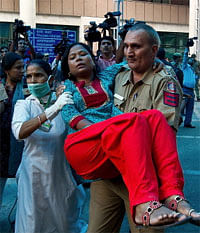Terror revisits Delhi, 11 killed

The high-intensity blast occured around 10:15 am at the reception area of Gate No 5 of the high court at a time when the place was teeming with people — clients assisted by their lawyers were standing in a three-line queue awaiting their turn to collect passes to enter the courtrooms.
Within minutes of the explosion, the Harkat-ul-Jehadi-Islami (HuJI) claimed responsibility for the attack. An e-mail sent from the id harkatuljihadi2011@gmail.com claimed that the HuJI carried out the blast in retaliation for Parliament attack convict Afzal Guru’s death sentence.
The first attack at the Delhi High Court took place on May 25 when a low-intensity bomb went off in the parking lot, but there were no casualties.
The high court is situated at the heart of Delhi’s VIP district and is a stone’s throw away from the landmark India Gate. It is situated close to ministers’ bungalows and Parliament which was in session when the bomb went off. The blast took place a day before Parliament’s monsoon session was to end.
A rattled government immediately formed a 20-member team of investigators drawn from the National Investigation Agency (NIA) to probe the blast. NIA chief S C Sinha said the agency had collected evidence from the blast site and conducting tests to find out the nature of the explosive used. The origins of the email reportedly sent by the HuJI to claim responsibility for the blast was also being verified.
As the bomb exploded, there was complete chaos. Amid shattered metal barricades, broken furniture, bloodied limbs and body parts, people ran helter-skelter, some shrieking for help while others tried helping the injured.
The mangled bodies of the dead lay in pools of blood. The perimeter wall was splattered with human flesh and blood as the police arrived to clear the area and send the injured people to hospitals. The intensity of the blast was such that it left, according to Union Home Secretary R P Singh, a 3-4 feet crater at the spot. Home Ministry Special Secretary (internal security) U K Bansal said there was possible use of nitrate-based explosive.
The Delhi Police said ammonium nitrate could have been used, indicating that the culprits had fabricated a sophisticated bomb. Deputy Commissioner of Police heading the crime unit Ashok Chand said “shrapnels” were used in rigging the bomb. Responding to questions, Singh said there was no intelligence on the attack, although Home Minister P Chidambaram contradicted him saying intelligence was shared with Delhi Police in July.
Describing the explosion as a terrorist attack, Chidambaram said the security agencies had received information about a possible attack in July but he did not elaborate on the report, leaving security experts to question the intelligence agencies’ preparedness to prevent bomb attacks.
Condemning the blast, Prime Minister Manmohan Singh said in Dhaka, where he is on a two-day visit, that it was “a cowardly act of a terrorist nature. We will deal with it. We will never succumb to the pressure of terrorism.” By evening, Delhi Police released sketches of the suspects, one of whom is around 26 years of age and 5’9” tall, while the second is believed to be around 50 years.
Wednesday’s attack is the worst terror attack in the capital since the triple blasts on September 13, 2008 when 25 people were killed. On September 13, 2008 serials blasts rocked Karol Bagh, Connaught Place and Greater Kailash injuring over 150 people.